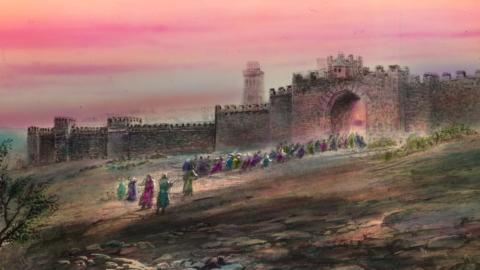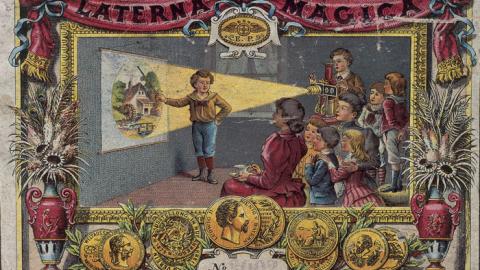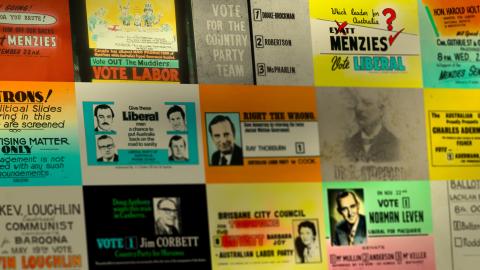
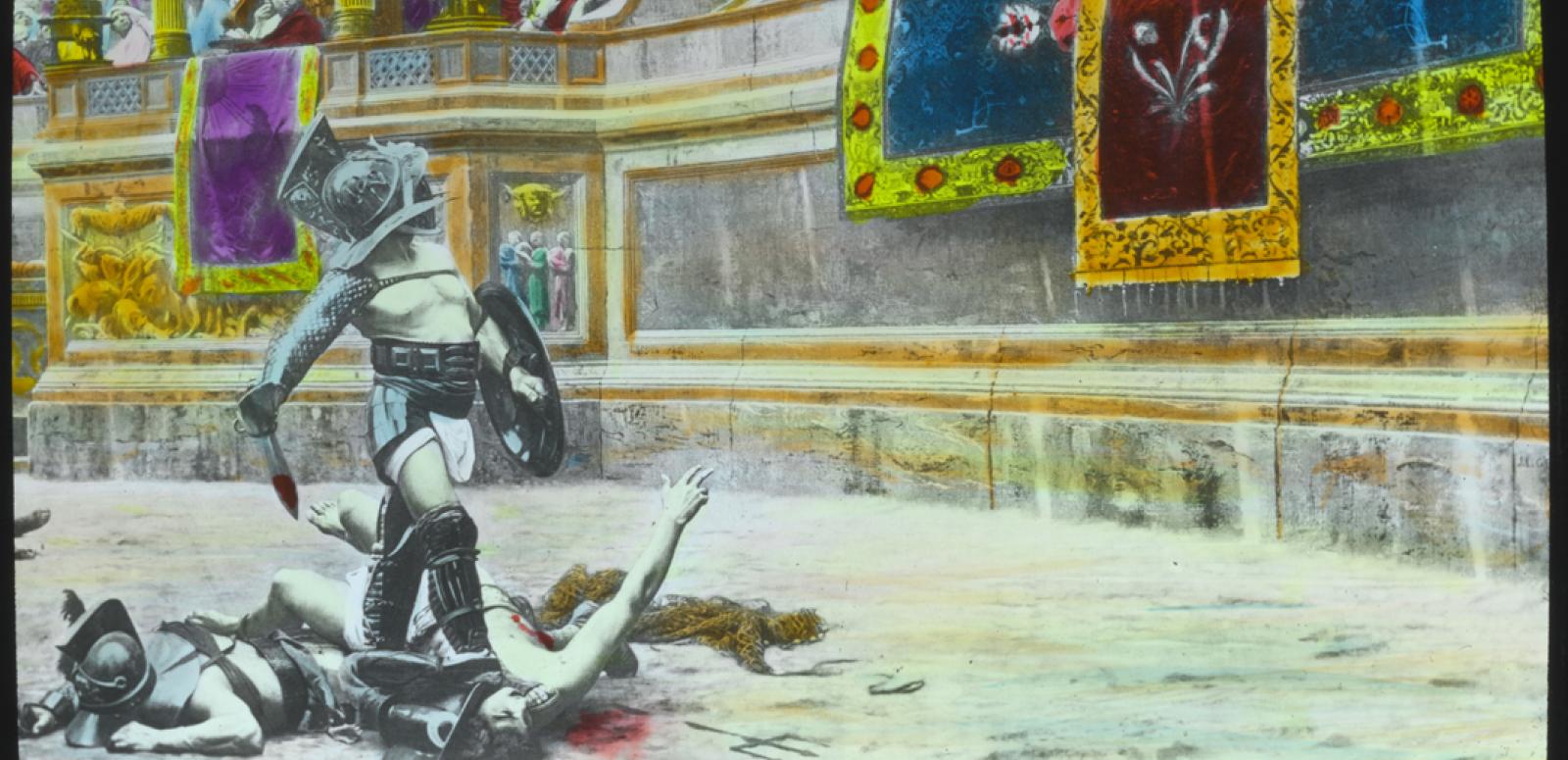
The Quo Vadis connection
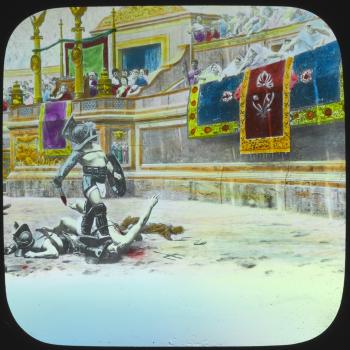
One of the highlights of my SAR Fellowship on The significance of the NFSA’s glass lantern-slide collection a couple of years ago was the chance to see the 200 or so glass magic lantern slides from Soldiers of the Cross on the light-table out at the NFSA’s facility in Mitchell, ACT.
I’m very interested in magic lantern slides and the history of the magic lantern in Australia. I suspected that these slides hadn’t yet received the attention they deserved, because Soldiers of the Cross – an evangelical lecture produced by the Salvation Army in Melbourne in 1900 – had been thought about by historians primarily interested in finding the origins of Australia’s cinema industry and, of course, the Australian cinematic part of the original presentation (13 or so kinematographic films) is now lost.
The slides, however, far from being just the remnants of a primarily movie-related event, are fascinating in their own right.
There is a lot of visual information recorded on the 9×9 cm glass slides, not to mention their extravagant hand-colouring, and their careful and inventive narrative sequencing. One of the people responsible for their production was also the youngest son of the founder of the Salvation Army, Herbert Booth. He left the Army in 1902 and took the slides with him overseas as an independent evangelist. He died in 1926, and the slides he had used for all those years didn’t return to Australia until the 1950s.
I gained access to some of the high resolution digital copies produced by the NFSA in order to show them as part of Arc Cinema’s Cinema’s Golden Summer program. It was wonderful to be able to dive into the detail in the slides, particularly the faces of the members of the Salvation Army who had dressed up as Romans or Christian martyrs to re-enact the stories of the persecution of the early Christians. By showing the slides in sequence I established that there were several distinct modes of temporality in the production, including what I dubbed the ‘iterative’, ‘expository’ and ‘action’ modes.
We had always known that some of the slides in the set that came back to Australia had been made a long time after the original production — the tableaus were more complex and the costumes and sets more elaborate. So I became intrigued to know where exactly the later slides had come from. At the Salvation Army Heritage Centre in Melbourne I had been shown a page from the Illustrated London News of 1907 where Booth was featured with his ‘evangelisation by tableaux vivants’ and ‘bioscope lecture’, so Booth was ‘on the road’ with slides and film for quite a long time. He was still touring when his first wife died in 1920.
I showed some of the later slides to colleagues in the lantern-slide researcher community, as well as the cinema historian community, and dropped them into Google Image Search. I found that some were actually production stills from the 1913 Italian blockbuster Quo Vadis. NFSA Chief Cinema Programmer Quentin Turnour had also cunningly programmed Quo Vadis into the NFSA’s season of Cinema’s Golden Summer, and when I saw the film at Arc cinema I identified 12 slides from the NFSA’s Soldiers of the Cross set as having their origin in Quo Vadis. They were most probably a set made by a commercial slide manufacturer in association with the exhibition of the blockbuster, purchased by Booth, and then interleaved amongst the existing Soldiers of the Cross set.
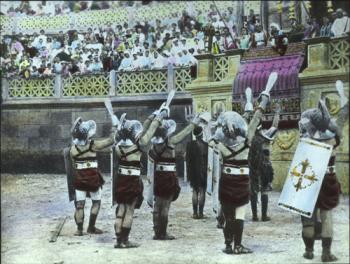
Back in 1900 the Salvation Army had incorporated slides of many famous 19th century paintings directly in their production, as well as using them as inspiration for their painted backdrops. Two of the paintings they had used, Thumbs Down and Last Prayers of the Christian Martyrs featured scenes in the Coliseum and were by the popular French academic painter Jean Léon Gérome, also known for his softcore porn harem scenes.
The same paintings were clearly also the inspiration for the sets and costumes of the 1913 Italian Quo Vadis. My ANU colleague Gino Moliterno alerted me to an article by Ivo Blom about the relationship of Gérome’s paintings to the Quo Vadis film where, as in Soldiers of the Cross, several scenes are directly modelled on the paintings. Blom’s article also discussed the relationship between the tableau vivant and early European cinema, as well as the general interest in ‘sword and sandal’ (or what I prefer to call ‘blood on the toga’) themes from the 19th century into the 20th century, and indeed right up to the present day, including the Quo Vadis novel about early Christian martyrs published in 1895.
Clearly much work remains to be done. But I think we now have a richer, more international and more inter-medial context for the NFSA’s Soldiers of the Cross slides.
In thinking about the narrative and temporal sequencing of these slides I had relied on the numbers painted on the edge of each slide. But the numbering system incorporates the Quo Vadis slides so these numbers were added after 1913, at least 13 years after the first slides were produced back in Melbourne. What was going through Booth’s head, I wondered, as he interleaved, amongst the slides he himself had produced a decade and a half earlier, the new slides from a mega commercial blockbuster which drew on the same literary and visual sources he had drawn on. But I think Lindsay Cox from the Salvation Army Heritage Centre gets it right when he says:
'First and foremost the prime motivation in Herbert Booth’s life was the spreading of the Gospel of Jesus Christ. It consumed him in his Salvation Army service and then as ‘Ambassador’ Booth the travelling evangelist. His creativeness and entrepreneurial skills were in their entirety for his work for God. The production achievements of Herbert were entirely a means to an end. If Herbert could not see a direct connection between using the technology and the saving of souls, he would have discarded it. Herbert Booth was adamant that his lecture was ‘not an entertainment.’ As commander of the Australasian Territory he was able to draw upon resources he never could have after leaving the Army. He was not a wealthy man, although no doubt, comfortable. Nor was his family wealthy, or able to, or perhaps desiring to support him. So, I do not feel that he had the resources to make the slides himself. There is also no evidence that he had anything other than artistic involvement in the productions. All the technical and processing stuff was Perry’s domain. I’m comfortable with the thought he just used whatever commercially available slides were available.'
The National Film and Sound Archive of Australia acknowledges Australia’s Aboriginal and Torres Strait Islander peoples as the Traditional Custodians of the land on which we work and live and gives respect to their Elders both past and present.
